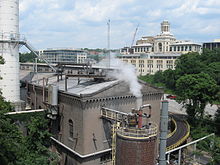Bellefield Boiler Plant

Bellefield Boiler Plant,also known as "The Cloud Factory"from its nickname's use inMichael Chabon's 1988debut novelThe Mysteries of Pittsburgh,[1]is aboiler plantlocated inJunction Hollow(referred to as "The Lost Neighborhood" in Chabon's book) between theCarnegie Institute of PittsburghandCarnegie Mellon Universityin theOaklanddistrict ofPittsburgh,Pennsylvania.
Built in 1907 to provide steam heat forCarnegie Museum,it was designed in theRomanesque Revivalstyle by the architectural firmLongfellow, Alden & Harlow.The 1907 smoke stack measured 150 feet (removed in 2010), and the newer stack (unknown built year) is more than 200 feet. The plant has burned bothcoalandnatural gasbut stopped burning coal on July 1, 2009. Its steam system expanded in the 1930s to service theUniversity of Pittsburgh'sCathedral of Learning.Today it pumps heat to most of the major buildings in Oakland. It is owned by a consortium made up of theUniversity of Pittsburgh,University of Pittsburgh Medical Center,Carnegie Mellon University,theCarnegie Museum,the City of Pittsburgh, and thePittsburgh Public Schools.
During its coal burning years, the plant could consume up to a 70-tonhopper carof coal per day, delivered by thePittsburgh Junction Railroad(now in theP&W Subdivisionof CSX) that ran through Junction Hollow next to the plant. The plant's small 1942PlymouthDE 25T locomotive[2]would shuttle the cars between the siding and the plant via a wooden trestle bridge[3](demolished 2012) spanning Boundary Street.


According to reporting by thePittsburgh Post-Gazette[4]the 2007 filmThe Mysteries of Pittsburghdoes not use the actual Bellefield Boiler Plant, but instead uses what remains of theCarrie Furnace,a storied blast furnace that was part ofUS Steel's Homestead Works, a few miles south inSwissvale, Pennsylvania.
Source of the phrase the "Cloud Factory"[edit]

Chabon may have coined the name "Cloud Factory" himself, or heard it first from locals before employing it to great effect in his novel. It is also possible that he may have borrowed the phrase fromHenry David Thoreau's essayKtaadn and the Maine Woods,[5]which was first published in five serialized installments inSartain'sUnion Magazinein 1848. The piece describes atranscendental,"mountain-top" experience Thoreau had in the summer of 1846 while hikingMount KatahdininMaine:
Sometimes it seemed as if the summit would be cleared in a few moments, and smile in sunshine; but what was gained on one side was lost on another. It was like sitting in a chimney and waiting for the smoke to blow away. It was, in fact, acloud factory—these were the cloud-works, and the wind turned them off done from the cool, bare rocks.
References[edit]
- ^Chabon, Michael (1988).The mysteries of Pittsburgh(1st ed.). New York: W. Morrow.ISBN0-688-07632-7.
- ^"Plymouth Industrial Locomotives Part 2".North East Rails.describes the locomotive as "Ply DE 25T, ex USN65-00278 blt 1942 cn4417."
- ^"RR bridge at Carnegie" Cloud Factory "".Bridges and Tunnels of Allegheny County and Pittsburgh, PA.
- ^Vancheri, Barbara (October 17, 2006)."No mystery: Writer-director knew he was the one to bring Chabon novel to the screen".Pittsburgh Post-Gazette.Retrieved15 October2015.
- ^Thoreau, Henry David (1988).The Maine woods.New York, N.Y.: Penguin Books.ISBN0-14-017013-8.

